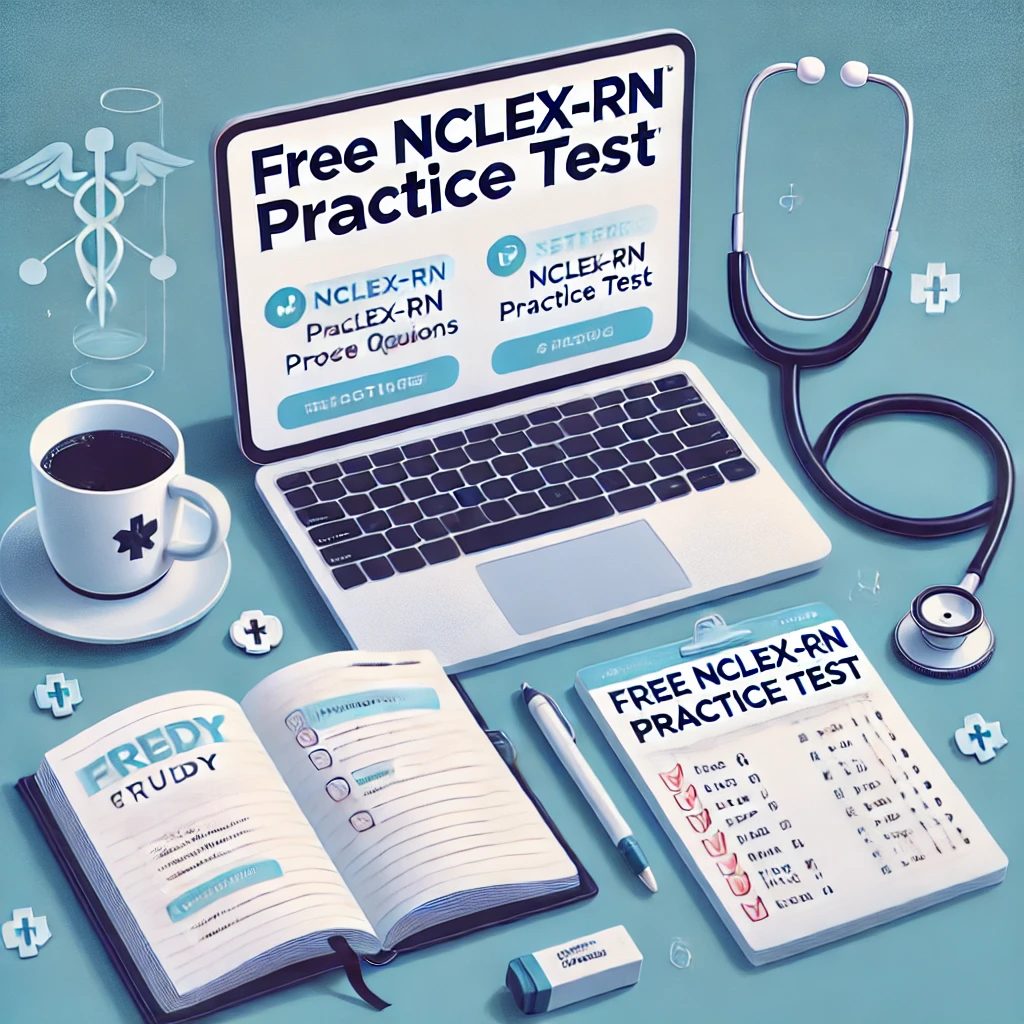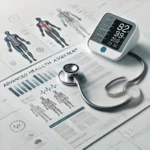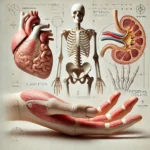Download free nclex-rn practice tests 2024-2025
The NCLEX-RN (National Council Licensure Examination for Registered Nurses) is a critical milestone for aspiring nurses in the U.S. and Canada. It serves as the licensing examination required to ensure that nursing graduates possess the necessary skills and knowledge to provide safe and effective patient care. The exam is comprehensive, testing critical thinking, clinical judgment, and the ability to apply nursing knowledge in real-world scenarios.
Table of Contents
ToggleWhy Are Practice Tests Important for NCLEX-RN Preparation?
NCLEX-RN preparation can be overwhelming due to the complex and adaptive nature of the exam. Practice tests are an essential tool for students to assess their readiness and improve their performance in several key areas. Below are some of the main benefits of using practice tests as part of NCLEX-RN preparation:
1. Familiarization with the Exam Format
The NCLEX-RN exam uses a Computerized Adaptive Testing (CAT) system, meaning the difficulty of the questions adapts to the test-taker’s ability as they progress. Practice tests allow students to get accustomed to this adaptive format, so they aren’t surprised on exam day. By repeatedly practicing with realistic test questions, students learn how to navigate through various question types, including multiple-choice, select-all-that-apply, and drag-and-drop questions. Familiarity with these formats reduces test anxiety and helps students feel more comfortable during the actual exam
2. Identifying Knowledge Gaps
One of the greatest advantages of using nursing test banks and practice questions is their ability to pinpoint areas of weakness in a student’s knowledge base. After completing practice exams, students can review their results to identify specific content areas—such as pharmacology, patient safety, or health promotion—that need further attention. This targeted approach ensures that students spend their study time efficiently, addressing their weakest subjects instead of wasting time on content they have already mastered
3. Building Confidence and Improving Time Management
The NCLEX-RN is a timed exam, with candidates typically having between 75 and 145 questions to complete within a specified time. Time management can be challenging, as students must pace themselves while maintaining accuracy. Practice tests help students practice managing their time effectively, ensuring they can answer questions at a steady pace without feeling rushed. This also builds confidence, as students become accustomed to the pressure of answering within the time constraints. Consistent practice helps them become more adept at making quick yet accurate decisions under pressure
The NCLEX-RN exam assesses a broad range of topics across four major categories: Safe and Effective Care Environment, Health Promotion and Maintenance, Psychosocial Integrity, and Physiological Integrity. Practice tests mirror this structure by covering all these areas, allowing students to engage in balanced preparation. The practice tests’ adaptive nature further reflects the NCLEX’s approach to testing varying difficulty levels, enhancing the relevance of the test prep and its alignment with the actual exam format.
By incorporating regular practice tests, nursing students not only prepare for the type of questions they’ll face but also optimize their study strategies by focusing on areas that require more attention, improving their ability to succeed on the exam day.
Benefits of Free NCLEX Practice Tests
Free NCLEX-RN practice tests provide an accessible way for nursing students to begin their preparation without financial pressure. These resources:
- Offer a realistic preview of the exam format.
- Help evaluate readiness and identify knowledge gaps.
- Allow repeated practice to improve accuracy and speed.
- Support efficient study planning by focusing on weaker areas.
By incorporating free NCLEX practice questions into their study routines, nursing students can strengthen their grasp of core concepts and enhance their ability to tackle the exam with confidence. Let me know if you’d like further details on effective study strategies or resources!
What to Expect in a Free NCLEX-RN Practice Test
When preparing for the NCLEX-RN, taking practice tests is a critical way to familiarize yourself with the format, structure, and types of questions you’ll encounter. Here’s what you can expect from a typical free NCLEX-RN practice test:
1. Categories Covered in NCLEX-RN Practice Tests
The NCLEX-RN exam is divided into four major categories that represent the different aspects of nursing practice. A good practice test will mirror these categories to ensure balanced preparation. These include:
- Safe and Effective Care Environment: Focuses on patient safety, infection control, and managing care environments.
- Health Promotion and Maintenance: Addresses preventative healthcare, wellness, and teaching health promotion strategies.
- Psychosocial Integrity: Involves mental health care, therapeutic communication, and dealing with stress and trauma.
- Physiological Integrity: Covers concepts related to the physical well-being of patients, such as pharmacology, nutrition, and medical-surgical care
A free NCLEX-RN practice test will typically include a mix of questions from each of these categories to give you a well-rounded experience and to ensure that you’re studying all areas required by the exam.
2. Question Formats
The NCLEX-RN uses various question types to assess nursing knowledge and clinical judgment. A good practice test will include:
- Multiple-Choice Questions: These are the most common type of question on the exam. You’ll be asked to select the correct answer from a list of options, which can test everything from simple knowledge recall to complex decision-making
- Select-All-That-Apply (SATA): These questions require you to select multiple correct answers, testing your deeper understanding of a topic. They are often more challenging because there are more than one correct answer
- Drag-and-Drop: In this format, you’ll be asked to arrange items or steps in a specific order, such as prioritizing nursing interventions in a patient care scenario. This tests your critical thinking and ability to apply knowledge in real-life situations
- Case Studies: These questions involve patient scenarios where you must analyze data, determine the most appropriate action, and make clinical decisions. Case studies simulate real-world situations and are particularly helpful in assessing your ability to apply theoretical knowledge in practice
3. Mimicking the Real Exam Experience
Free NCLEX-RN practice tests are designed to mimic the actual exam experience. Here’s how:
- Computerized Adaptive Testing (CAT): The NCLEX-RN exam uses a CAT system, where the difficulty of questions adjusts based on your performance. As you answer correctly, the questions get harder; if you answer incorrectly, they become easier. Many practice tests use similar algorithms to provide an adaptive learning experience
- Timed Format: The real NCLEX-RN has a strict time limit. Practice tests often simulate this by including time limits for each question or for the entire test. This helps you get used to managing time effectively during the actual exam
- Realistic Rationales: Many free practice tests offer detailed rationales for each answer choice, helping you understand why an answer is correct or incorrect. This simulates the learning process you’ll need during your preparation, enhancing your understanding of the material
By regularly taking practice tests, you get an opportunity to experience how the NCLEX-RN feels and prepare for the pressure of timed, adaptive questions. They also allow you to evaluate your readiness, track progress, and identify areas that need more attention before exam day.
Free NCLEX-RN Practice Questions: Try These Now
1. Pharmacology:
Question:
A nurse is administering warfarin to a patient with atrial fibrillation. The patient’s most recent INR is 3.5. What is the nurse’s next action?
A) Administer the warfarin as prescribed
B) Hold the warfarin and notify the healthcare provider
C) Administer a reduced dose of warfarin
D) Encourage the patient to increase their vitamin K intake
Answer:
B) Hold the warfarin and notify the healthcare provider
Explanation: An INR of 3.5 is above the therapeutic range (typically 2.0-3.0 for patients on warfarin), which increases the risk for bleeding. The nurse should hold the dose and notify the healthcare provider for further action, which may include a dose adjustment or vitamin K administration.
2. Patient Safety:
Question:
A nurse is caring for a patient who is at risk for falls. Which of the following actions is most appropriate to reduce the risk of falling?
A) Place the patient’s call light within easy reach
B) Use a bed alarm at all times
C) Have a family member stay with the patient at all times
D) Keep the room well-lit with no obstacles
Answer:
A) Place the patient’s call light within easy reach
Explanation: While all the options can help reduce the risk of falling, the most immediate and effective action is ensuring that the patient can easily call for help. Keeping the call light in reach empowers the patient to request assistance before attempting to get out of bed unassisted.
3. Health Promotion:
Question:
A nurse is providing education on breast cancer prevention to a 35-year-old woman. Which of the following statements by the nurse is appropriate?
A) “You should begin getting mammograms every year starting at age 40.”
B) “Exercise and a balanced diet can help lower your risk of breast cancer.”
C) “You should start performing self-breast exams after age 50.”
D) “There is no need for you to worry about breast cancer until you are 50.”
Answer:
B) “Exercise and a balanced diet can help lower your risk of breast cancer.”
Explanation: A healthy lifestyle, including regular exercise and a balanced diet, can reduce the risk of many cancers, including breast cancer. Mammograms typically begin at age 40, but lifestyle factors can influence risk at any age. Self-breast exams and other preventative measures should be discussed regularly with healthcare providers.
4. Physiological Integrity:
Question:
A nurse is caring for a patient with diabetic ketoacidosis (DKA). Which of the following is a priority intervention?
A) Administer a bolus of insulin
B) Rehydrate the patient with IV fluids
C) Monitor the patient’s blood glucose every hour
D) Initiate a low-sodium diet
Answer:
B) Rehydrate the patient with IV fluids
Explanation: Rehydration is the priority in managing DKA to correct dehydration and electrolyte imbalances. Insulin administration and monitoring blood glucose are important, but fluid resuscitation is the first step in treatment.
5. Psychosocial Integrity:
Question:
A nurse is caring for a patient with severe anxiety disorder. Which of the following interventions is most appropriate to reduce anxiety during an acute episode?
A) Encourage the patient to talk about their feelings
B) Offer a relaxing activity such as deep breathing or listening to music
C) Discuss past stressors with the patient to uncover triggers
D) Provide a medication to calm the patient immediately
Answer:
B) Offer a relaxing activity such as deep breathing or listening to music
Explanation: During an acute anxiety episode, it’s most helpful to offer a calming intervention like deep breathing or music. While medication can be used in certain cases, non-pharmacological interventions like relaxation techniques are preferred in the immediate moment.
6. Pharmacology:
Question:
A nurse is caring for a patient who is receiving intravenous morphine for pain relief after surgery. The patient’s respiratory rate is 10 breaths per minute. What is the nurse’s priority action?
A) Administer naloxone (Narcan)
B) Increase the morphine infusion rate
C) Assess the patient’s oxygen saturation
D) Continue monitoring the patient’s vital signs
Answer:
A) Administer naloxone (Narcan)
Explanation: A respiratory rate of 10 breaths per minute is dangerously low and indicative of opioid-induced respiratory depression. Naloxone is an opioid antagonist that can reverse respiratory depression caused by morphine overdose, making it the priority intervention. The nurse should also assess the patient’s oxygen saturation and provide supplemental oxygen if needed.
7. Patient Safety:
Question:
A nurse is caring for a postoperative patient who is at risk for deep vein thrombosis (DVT). Which intervention is most important for preventing DVT in this patient?
A) Encourage the patient to ambulate every 2 hours
B) Apply compression stockings
C) Administer anticoagulants as prescribed
D) Increase the patient’s fluid intake
Answer:
A) Encourage the patient to ambulate every 2 hours
Explanation: Ambulation is the most effective intervention for preventing DVT, as it helps promote circulation and reduces the risk of blood clots. While compression stockings, anticoagulants, and increased fluid intake are also beneficial, regular movement is key to reducing the risk of DVT in postoperative patients.
8. Health Promotion:
Question:
A nurse is educating a group of young adults on the importance of cancer screening. What is the best response from the nurse regarding colon cancer screening?
A) “Screening should begin at age 40 for individuals with no family history of cancer.”
B) “Regular colon cancer screenings should begin at age 50 for most individuals.”
C) “You should begin screenings at age 30, regardless of your family history.”
D) “There are no guidelines for colon cancer screening for individuals under 50.”
Answer:
B) “Regular colon cancer screenings should begin at age 50 for most individuals.”
Explanation: For individuals at average risk, the American Cancer Society recommends beginning colon cancer screening at age 45 or 50, depending on individual risk factors. Early screenings may be necessary for those with a family history of colon cancer or genetic predispositions.
9. Physiological Integrity:
Question:
A nurse is caring for a patient who is receiving chemotherapy for lung cancer. The patient reports feeling extremely fatigued and is unable to get out of bed. Which intervention is the nurse’s priority?
A) Encourage the patient to take frequent rest breaks
B) Assess the patient’s hemoglobin and hematocrit levels
C) Offer the patient small, frequent meals throughout the day
D) Administer a prescribed dose of antiemetic medication
Answer:
B) Assess the patient’s hemoglobin and hematocrit levels
Explanation: Fatigue is a common side effect of chemotherapy, and it can be exacerbated by anemia, which is common in cancer patients. The nurse should assess hemoglobin and hematocrit levels to determine if anemia is contributing to the fatigue. Additional interventions such as providing rest, nutrition, and antiemetics can be helpful, but the priority is to assess for anemia.
10. Psychosocial Integrity:
Question:
A nurse is caring for a patient who has been diagnosed with major depressive disorder. The patient expresses feelings of hopelessness and says, “Nothing will ever get better.” What is the nurse’s best response?
A) “You just need to stay positive and things will improve.”
B) “You don’t need to worry; everything will be okay soon.”
C) “I understand that you’re feeling hopeless, but let’s talk about ways to improve your mood.”
D) “I’m sure this will pass. It’s just a phase you’re going through.”
Answer:
C) “I understand that you’re feeling hopeless, but let’s talk about ways to improve your mood.”
Explanation: Acknowledging the patient’s feelings and offering to explore ways to improve their mood shows empathy and opens the door for therapeutic communication. Telling the patient to “stay positive” or “everything will be okay soon” minimizes their feelings and may not address their need for professional mental health support.
11. Management of Care:
Question:
A nurse is coordinating care for a patient undergoing a major surgical procedure. The patient asks how the nurse will ensure their care is prioritized. What is the nurse’s most appropriate response?
A) “I will make sure you receive your medications on time and check on you regularly.”
B) “I will ensure your procedure goes smoothly and update your family as needed.”
C) “I will be in charge of your care and will make decisions for you.”
D) “I will communicate with the healthcare team to ensure we’re all aligned in providing your care.”
Answer:
D) “I will communicate with the healthcare team to ensure we’re all aligned in providing your care.”
Explanation: Effective care coordination involves collaborating with the entire healthcare team to ensure the patient’s needs are met. This response demonstrates the nurse’s commitment to holistic, patient-centered care while ensuring that all members of the healthcare team are working together.
12. Pharmacology:
Question:
A nurse is administering furosemide (Lasix) to a patient with heart failure. The nurse notes that the patient’s potassium level is 3.0 mEq/L. What should the nurse do next?
A) Administer the furosemide as prescribed
B) Hold the furosemide and notify the healthcare provider
C) Administer a potassium supplement as prescribed
D) Encourage the patient to eat potassium-rich foods
Answer:
B) Hold the furosemide and notify the healthcare provider
Explanation: Furosemide is a diuretic that can cause potassium depletion. A potassium level of 3.0 mEq/L is considered low, and the nurse should hold the furosemide and notify the healthcare provider to avoid further lowering potassium levels. The healthcare provider may adjust the medication or prescribe a potassium supplement.
13. Patient Safety:
Question:
A nurse is caring for a patient who is receiving a blood transfusion. During the transfusion, the patient develops chills, fever, and back pain. What is the nurse’s priority action?
A) Administer acetaminophen to reduce the fever
B) Stop the transfusion immediately and notify the healthcare provider
C) Apply a warm compress to the patient’s back
D) Take the patient’s vital signs and continue monitoring the transfusion
Answer:
B) Stop the transfusion immediately and notify the healthcare provider
Explanation: The symptoms of chills, fever, and back pain are indicative of a transfusion reaction. The nurse’s priority is to stop the transfusion immediately to prevent further complications and notify the healthcare provider for further assessment and intervention.
14. Health Promotion:
Question:
A nurse is providing education on the importance of immunization to a new mother. Which of the following vaccines should be administered to the infant at 2 months of age?
A) MMR (measles, mumps, rubella)
B) DTaP (diphtheria, tetanus, and acellular pertussis)
C) Hepatitis B
D) Varicella
Answer:
B) DTaP (diphtheria, tetanus, and acellular pertussis)
Explanation: According to the Centers for Disease Control and Prevention (CDC), the DTaP vaccine is given at 2 months of age as part of the routine childhood immunization schedule. The MMR and varicella vaccines are typically given at 12 months, while hepatitis B is usually administered at birth, 1-2 months, and 6-18 months.
15. Physiological Integrity:
Question:
A nurse is caring for a patient with chronic obstructive pulmonary disease (COPD) who is receiving oxygen therapy. The nurse notes that the patient’s oxygen saturation is 88%. What is the nurse’s priority intervention?
A) Increase the oxygen flow rate
B) Place the patient in a high-Fowler’s position
C) Administer a bronchodilator as prescribed
D) Call the healthcare provider immediately
Answer:
B) Place the patient in a high-Fowler’s position
Explanation: Placing the patient in a high-Fowler’s position (sitting upright) is the priority intervention as it helps to improve lung expansion and oxygenation. While increasing the oxygen flow rate or administering a bronchodilator might be necessary, positioning the patient correctly should be the first action.
16. Psychosocial Integrity:
Question:
A nurse is caring for a patient with post-traumatic stress disorder (PTSD). The patient reports frequent nightmares and hypervigilance. Which therapeutic approach is most appropriate for this patient?
A) Cognitive-behavioral therapy (CBT)
B) Electroconvulsive therapy (ECT)
C) Deep muscle relaxation techniques
D) Encouraging the patient to avoid discussing traumatic events
Answer:
A) Cognitive-behavioral therapy (CBT)
Explanation: Cognitive-behavioral therapy (CBT) is an evidence-based therapeutic approach that is effective in treating PTSD. It helps patients process and reframe their traumatic experiences. While relaxation techniques and ECT can be helpful in certain cases, CBT is considered the most appropriate first-line treatment for PTSD.
17. Management of Care:
Question:
A nurse is coordinating care for a patient who is scheduled for surgery the next day. The patient is anxious about the procedure and asks the nurse to explain the details again. What is the nurse’s most appropriate response?
A) “I have already explained everything, so you should feel comfortable with the procedure.”
B) “Let’s go over the details again to make sure you feel informed and ready.”
C) “I’ll have the surgeon come in to explain everything to you.”
D) “Don’t worry, everything will go smoothly tomorrow.”
Answer:
B) “Let’s go over the details again to make sure you feel informed and ready.”
Explanation: It is important to address the patient’s anxiety and ensure they fully understand the procedure. Re-explaining the details and providing the opportunity for questions helps the patient feel informed and more at ease. Dismissing the patient’s concerns or brushing them off may increase anxiety.
18. Infection Control:
Question:
A nurse is caring for a patient with an active Clostridium difficile (C. diff) infection. Which precaution should the nurse follow when caring for this patient?
A) Standard precautions only
B) Airborne precautions
C) Droplet precautions
D) Contact precautions
Answer:
D) Contact precautions
Explanation: C. difficile is transmitted through contact with contaminated surfaces or hands. Contact precautions, including the use of gloves and gowns, should be followed when caring for a patient with this infection. Hand hygiene with soap and water (rather than alcohol-based hand sanitizers) is essential to prevent the spread of the infection.
19. Nutrition:
Question:
A nurse is educating a patient with diabetes about healthy eating habits. Which of the following meals is the best option for this patient?
A) Grilled chicken breast, steamed broccoli, and a baked potato
B) Cheeseburger, french fries, and a soft drink
C) Fried chicken, mashed potatoes with gravy, and green beans
D) Egg salad sandwich on white bread and potato chips
Answer:
A) Grilled chicken breast, steamed broccoli, and a baked potato
Explanation: The meal of grilled chicken breast, steamed broccoli, and a baked potato is a healthy choice for a patient with diabetes as it includes lean protein, vegetables, and a moderate carbohydrate source. The other options are high in fats and refined carbohydrates, which can negatively impact blood sugar control.
20. Cardiovascular System:
Question:
A nurse is caring for a patient who has a prescription for digoxin (Lanoxin). The nurse notes that the patient’s heart rate is 48 beats per minute. What should the nurse do next?
A) Administer the medication as prescribed
B) Hold the medication and notify the healthcare provider
C) Decrease the dosage of digoxin
D) Increase the dosage to improve heart rate
Answer:
B) Hold the medication and notify the healthcare provider
Explanation: Digoxin can slow the heart rate, and a heart rate of 48 beats per minute is below the normal range. The nurse should hold the medication and notify the healthcare provider to assess whether adjustments are needed. A low heart rate can be a sign of digoxin toxicity.
21. Endocrine System:
Question:
A nurse is caring for a patient with newly diagnosed type 1 diabetes. The patient asks what causes the disease. Which of the following responses is most accurate?
A) “It is caused by a viral infection that affects insulin production.”
B) “It is caused by the body’s inability to produce insulin due to autoimmune destruction of beta cells in the pancreas.”
C) “It is caused by obesity and poor diet choices.”
D) “It is caused by the body becoming resistant to insulin.”
Answer:
B) “It is caused by the body’s inability to produce insulin due to autoimmune destruction of beta cells in the pancreas.”
Explanation: Type 1 diabetes is an autoimmune disease in which the body attacks and destroys the insulin-producing beta cells in the pancreas, leading to an inability to produce insulin.
22. Respiratory System:
Question:
A nurse is assessing a patient with asthma. The patient reports shortness of breath and wheezing. Which of the following medications would the nurse expect the healthcare provider to prescribe for acute asthma exacerbation?
A) Metoprolol
B) Albuterol
C) Fluticasone
D) Theophylline
Answer:
B) Albuterol
Explanation: Albuterol is a short-acting beta-agonist (SABA) that is commonly used for the quick relief of acute asthma symptoms, including wheezing and shortness of breath. It works by relaxing the bronchial muscles to open the airways.
23. Gastrointestinal System:
Question:
A nurse is caring for a patient who is receiving enteral feedings through a nasogastric (NG) tube. The nurse checks the placement of the NG tube by aspirating gastric contents. Which of the following findings indicates proper placement of the tube?
A) Greenish-yellow aspirate
B) Clear, colorless aspirate
C) Coffee-ground aspirate
D) Bilious, greenish aspirate
Answer:
A) Greenish-yellow aspirate
Explanation: Gastric contents are typically greenish-yellow due to bile and stomach acid. A clear, colorless aspirate could indicate that the tube is in the trachea, while coffee-ground or bilious aspirates suggest other complications.
24. Neurological System:
Question:
A nurse is caring for a patient with a head injury. The nurse observes that the patient is increasingly lethargic and is difficult to arouse. Which of the following actions should the nurse take first?
A) Administer an analgesic
B) Call the healthcare provider immediately
C) Perform a neurological assessment
D) Increase the patient’s oxygen flow rate
Answer:
C) Perform a neurological assessment
Explanation: The first step is to assess the patient’s neurological status to determine if there is a change in consciousness or other symptoms that require immediate intervention, such as a decrease in Glasgow Coma Scale (GCS) score.
25. Musculoskeletal System:
Question:
A nurse is caring for a patient who is recovering from hip replacement surgery. Which of the following interventions is most important in preventing dislocation of the hip?
A) Instruct the patient to avoid bending the hip more than 90 degrees
B) Position the patient with the legs adducted
C) Encourage the patient to turn to the affected side for comfort
D) Keep the patient’s legs in a neutral position at all times
Answer:
A) Instruct the patient to avoid bending the hip more than 90 degrees
Explanation: After hip replacement surgery, patients should avoid bending the hip more than 90 degrees to prevent dislocation of the new joint. Maintaining proper positioning is crucial for avoiding complications.
26. Pain Management:
Question:
A nurse is caring for a patient who is experiencing severe pain after surgery. The patient has a history of opioid addiction and asks for pain medication. What should the nurse do first?
A) Administer the prescribed opioid as ordered
B) Offer a non-pharmacological pain management technique first
C) Withhold pain medication and notify the healthcare provider
D) Ask the patient to rate their pain on a scale from 0 to 10
Answer:
D) Ask the patient to rate their pain on a scale from 0 to 10
Explanation: The first step in managing pain is to assess the patient’s pain level. Asking for a pain rating helps the nurse understand the severity of the pain and decide on the appropriate course of action. The nurse can then consider alternative methods or consult with the healthcare provider to manage pain appropriately.
27. Fluid and Electrolyte Balance:
Question:
A nurse is caring for a patient who has been vomiting and has low blood pressure. The patient’s serum sodium level is 128 mEq/L. Which of the following actions should the nurse take?
A) Encourage the patient to drink water
B) Administer normal saline IV as ordered
C) Increase the sodium intake in the diet
D) Hold all medications until sodium levels return to normal
Answer:
B) Administer normal saline IV as ordered
Explanation: A serum sodium level of 128 mEq/L is indicative of hyponatremia. The nurse should administer the prescribed IV fluids, such as normal saline, to help correct the sodium imbalance. Encouraging oral water intake may worsen the condition.
28. Integumentary System:
Question:
A nurse is caring for a patient with a stage II pressure ulcer on the sacrum. Which of the following interventions should the nurse include in the care plan?
A) Use a foam dressing to cover the ulcer
B) Apply an occlusive dressing with silver sulfadiazine
C) Ensure that the patient’s position is changed every 4 hours
D) Massage the area around the ulcer to improve circulation
Answer:
A) Use a foam dressing to cover the ulcer
Explanation: Foam dressings are commonly used for stage II pressure ulcers to provide moisture, absorb exudate, and promote healing. Changing the patient’s position at least every 2 hours is ideal, and massaging around the ulcer is contraindicated as it could damage the tissue further.
29. Renal System:
Question:
A nurse is caring for a patient with chronic kidney disease. The healthcare provider prescribes erythropoietin (Epogen) to treat anemia. What should the nurse monitor closely in this patient?
A) Serum potassium levels
B) Blood pressure
C) Serum sodium levels
D) Respiratory rate
Answer:
B) Blood pressure
Explanation: Erythropoietin (Epogen) stimulates red blood cell production, which can increase blood viscosity and lead to elevated blood pressure. Close monitoring of blood pressure is necessary to prevent complications such as hypertension and heart failure.
30. Hematology:
Question:
A nurse is preparing to administer a blood transfusion to a patient. What is the most important action the nurse should take before starting the transfusion?
A) Verify the patient’s blood type with the laboratory results
B) Administer a test dose of the blood
C) Ensure the patient has a valid prescription for the transfusion
D) Take the patient’s vital signs before starting the transfusion
Answer:
A) Verify the patient’s blood type with the laboratory results
Explanation: The most important step is verifying the patient’s blood type and crossmatch to ensure compatibility with the donor blood. This prevents dangerous transfusion reactions. Taking vital signs and ensuring a valid prescription are also important, but blood type verification is paramount.
31. Obstetrics and Gynecology:
Question:
A nurse is assessing a pregnant patient at 28 weeks gestation. The patient reports swelling of the legs and hands. Which of the following findings would the nurse interpret as a potential sign of preeclampsia?
A) Swelling of the legs after long periods of standing
B) Increased weight gain of 5 pounds in one week
C) Generalized swelling without hypertension
D) Swelling of the hands, face, and legs along with a headache and visual disturbances
Answer:
D) Swelling of the hands, face, and legs along with a headache and visual disturbances
Explanation: Preeclampsia is characterized by swelling (edema) of the face, hands, and legs, along with hypertension, headaches, and visual disturbances. This is a potentially life-threatening condition that requires immediate medical attention.
32. Psychiatric Nursing:
Question:
A nurse is caring for a patient diagnosed with schizophrenia who is experiencing auditory hallucinations. Which of the following interventions is the most appropriate?
A) Argue with the patient to prove the hallucinations are not real
B) Encourage the patient to ignore the voices
C) Focus on reality and discuss the hallucinations openly
D) Avoid discussing the hallucinations to prevent upsetting the patient
Answer:
C) Focus on reality and discuss the hallucinations openly
Explanation: While it’s important to acknowledge the patient’s feelings and experiences, focusing on reality and gently guiding the conversation away from the hallucinations is essential. Arguing or dismissing the experience may increase distress, while avoiding the topic altogether could hinder therapeutic communication.
33. Pediatrics:
Question:
A nurse is caring for a 5-year-old child with asthma who is having difficulty breathing. The nurse prepares to administer a nebulized bronchodilator. Which of the following actions should the nurse take?
A) Administer the bronchodilator through a metered-dose inhaler
B) Place the child in a supine position to maximize ventilation
C) Instruct the child to inhale deeply and hold their breath during treatment
D) Monitor the child’s heart rate before, during, and after treatment
Answer:
D) Monitor the child’s heart rate before, during, and after treatment
Explanation: Bronchodilators can increase heart rate as a side effect. Therefore, it is important to monitor the child’s heart rate to ensure there is no excessive tachycardia. Positioning the child upright may be more comfortable and improve respiratory function.
34. Infection Control:
Question:
A nurse is caring for a patient who has been diagnosed with tuberculosis (TB). Which of the following actions should the nurse take to prevent the spread of TB to other patients?
A) Place the patient in a private room with negative airflow
B) Administer antibiotics only when the patient shows signs of infection
C) Instruct the patient to wear a surgical mask at all times
D) Require the patient to take a shower before leaving the room
Answer:
A) Place the patient in a private room with negative airflow
Explanation: TB is an airborne infection, and patients should be placed in a private room with negative pressure ventilation to prevent the spread of the bacteria. This reduces the risk of exposure to other patients and staff.
35. Musculoskeletal:
Question:
A nurse is caring for a patient who has undergone a total knee replacement (TKR) surgery. Which of the following is the most important intervention to prevent complications following surgery?
A) Encourage the patient to perform deep breathing exercises
B) Elevate the affected leg on two pillows to reduce swelling
C) Apply ice packs to the affected area for 30 minutes every hour
D) Assist the patient in performing range-of-motion exercises
Answer:
B) Elevate the affected leg on two pillows to reduce swelling
Explanation: Elevating the affected leg helps reduce swelling and promotes circulation, which is essential after a TKR surgery. Ice packs can also be beneficial for reducing swelling, but proper elevation is typically the first priority.
Free NCLEX-RN Practice Test PDF for Download
Fore more free questions download this PDF file:
Best Strategies to Use Free NCLEX-RN Practice Tests Effectively
When preparing for the NCLEX-RN, free practice tests can be incredibly valuable, but to make the most of them, you need to approach them strategically. Here are some actionable tips to help you use free practice tests effectively:
1. Create a Study Schedule with Practice Tests
Developing a well-structured study schedule is essential to stay organized and ensure thorough preparation. Incorporate practice tests into your routine at strategic points to track progress and identify areas needing improvement.
- Start Early: Begin with foundational knowledge and gradually integrate practice tests as you gain confidence in the content. Early tests can serve as baseline assessments to identify your strengths and weaknesses.
- Spacing: Incorporate regular practice tests into your schedule—perhaps every week or bi-weekly—to help reinforce knowledge while simulating real exam conditions.
- Test Focus: Tailor your practice tests to specific areas you are struggling with or focusing on as you advance in your studies. For example, you might concentrate on pharmacology or patient safety in different sessions.
2. Analyze Results to Identify Strengths and Weaknesses
The key to using practice tests effectively lies in reviewing your results to understand where you need improvement. After taking each test, thoroughly analyze the feedback to maximize the learning process.
- Look Beyond the Score: Don’t just focus on the score. Instead, identify the specific areas where you made errors, and review those topics in-depth.
- Focus on Patterns: Are you consistently struggling with certain categories (e.g., pharmacology, health promotion, or safe and effective care)? This insight allows you to adjust your study approach accordingly, ensuring more efficient learning.
- Track Improvement: Keep track of your scores over time to gauge improvement. If you’re improving in specific areas, continue focusing on maintaining that progress, while devoting more attention to any ongoing weaknesses.
3. Combine Practice Tests with Other Study Resources
Free NCLEX-RN practice tests should be just one element of your study strategy. Combining them with other resources will give you a comprehensive preparation plan.
- Review Textbooks and NCLEX-RN Study Guides: Complement your practice test results by studying the topics in detail from your textbooks, review guides, or online resources. This will fill in any gaps in your knowledge.
- Use Active Learning Techniques: While practice tests give you a simulation of the exam format, supplement this by using active learning techniques, such as flashcards, summarizing, or teaching others, to enhance retention.
- Join Study Groups or Online Forums: Discussing questions and answers with others in a study group or online forum can provide different perspectives and insights into challenging topics, reinforcing your understanding.
By strategically incorporating practice tests, analyzing results, and combining them with diverse study methods, you can maximize the effectiveness of your NCLEX-RN preparation and significantly improve your chances of success.
Learn more about the top strategies for nursing students.
Paid vs. Free NCLEX-RN Resources: Which One Is Right for You?
When preparing for the NCLEX-RN, you’ll come across a variety of resources, both free and paid. Both options have their benefits, but they also come with limitations. Let’s break down the differences to help you choose the best study approach based on your needs.
Limitations of Free NCLEX-RN Resources
Free NCLEX-RN practice tests and study tools can be helpful, but they typically come with some limitations that might hinder in-depth preparation:
- Fewer Questions: Many free practice tests are limited in the number of questions they offer. This can restrict your exposure to the full range of topics covered on the actual exam. With fewer questions, you might miss practicing key areas that require attention.
- Limited Explanations: Free resources may provide basic explanations for correct or incorrect answers, but often, these explanations lack depth. In-depth rationales are crucial for understanding the “why” behind each question, which is essential for long-term retention.
- Basic Question Formats: Free resources may provide multiple-choice questions but lack more complex question types, such as drag-and-drop or case studies, which are increasingly common on the NCLEX-RN exam. This limits your ability to practice for all aspects of the test.
- Less Customization: Free tests often don’t offer personalized feedback or detailed progress tracking, making it harder to identify your specific areas of weakness over time.
Value of Paid NCLEX-RN Resources
On the other hand, premium study resources typically offer a more comprehensive and tailored study experience. Here’s why investing in a paid resource might be worth it:
- Comprehensive Question Banks: Premium resources often include a wider variety of practice questions that cover all categories of the NCLEX-RN exam. This allows for more comprehensive practice and helps ensure you’re exposed to a broad range of topics.
- Detailed Rationales and Explanations: With paid resources, you typically get access to detailed rationales for every question, explaining the reasoning behind the correct and incorrect answers. This helps deepen your understanding and retention of critical concepts.
- Simulation of the Actual Exam: Paid tools often offer realistic exam simulations that closely mimic the actual NCLEX-RN test environment. These simulations can help you get accustomed to the time pressure and different question formats you’ll encounter on exam day.
- Personalized Feedback and Analytics: Many paid NCLEX-RN test banks offer detailed analytics to track your performance, showing you which areas need improvement. This helps you focus your study sessions on the weakest areas and gauge your readiness for the exam.
While free resources can be a good start, if you’re aiming for a more thorough, high-quality study experience, investing in premium resources can offer more value and ultimately better preparation for the NCLEX-RN.
For an extensive range of NCLEX-RN practice questions, rationales, and exam simulations, consider exploring premium NCLEX test banks to maximize your chances of success.
Tips for Succeeding on the NCLEX-RN Exam
Succeeding on the NCLEX-RN exam requires more than just memorization; it requires smart, strategic preparation. Below are additional study tips that can help you excel and feel more confident on exam day.
1. Use Flashcards and Cheat Sheets
Flashcards and cheat sheets are powerful tools for reinforcing key concepts, improving retention, and speeding up your recall during the exam.
- Flashcards: Create flashcards for important terms, pharmacology drugs, diagnostic tests, and patient care protocols. Regularly review these to strengthen memory. Flashcards are especially useful for high-yield topics like medical-surgical nursing and pharmacology.
- Cheat Sheets: Write concise notes on cheat sheets for complex topics, including formulas, normal lab values, and quick nursing interventions. Keep these sheets handy for quick revision and to familiarize yourself with critical concepts.
These methods leverage active recall, which is proven to enhance long-term retention and test performance.
2. Join Study Groups
Study groups can offer unique benefits that you might not achieve studying alone:
- Collaborative Learning: By joining a study group, you can discuss difficult topics, exchange study materials, and challenge each other’s understanding of key concepts. Explaining topics to peers helps solidify your knowledge and clarify areas of confusion.
- Accountability: Study groups provide a level of accountability that can help you stay consistent with your study plan. Knowing that others are depending on you to stay on track can be a powerful motivator.
- Support: NCLEX preparation can feel isolating at times, but study groups offer emotional and academic support. Sharing study experiences and coping strategies can keep you motivated.
Be sure to choose a study group that stays focused on NCLEX material and schedules regular, effective study sessions.
3. Stay Consistent with Preparation
Consistency is key when preparing for the NCLEX-RN exam. Here’s how to maintain momentum throughout your study plan:
- Set a Routine: Develop a study schedule that fits into your daily life and stick to it. Consistent study sessions, even if they are short, are more effective than cramming at the last minute.
- Balanced Approach: Don’t just focus on your weaknesses; make time to review your strengths too. A balanced study approach will help prevent burnout and ensure you’re well-rounded in your knowledge.
- Self-Care: Make time for rest and relaxation. Overworking yourself can lead to burnout, negatively impacting your exam performance. Take regular breaks, get enough sleep, and stay hydrated to ensure peak performance when studying.
By sticking to a routine, reviewing regularly, and practicing good self-care, you’ll build the confidence and resilience needed to succeed on the NCLEX-RN.
Using these strategies alongside practice tests will help you master the content and be fully prepared for exam day. Consistency, smart study tools, and peer support are all part of the formula for success.














